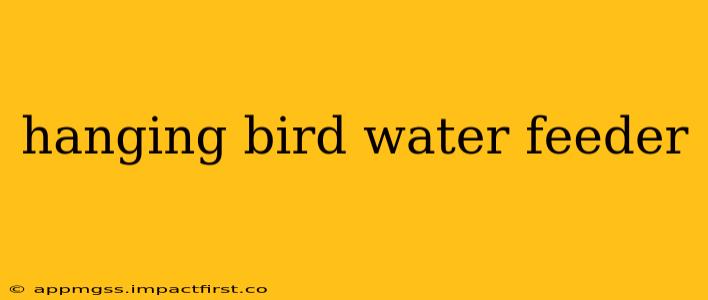Providing a clean water source for birds is crucial for their survival, especially during hot weather. Hanging bird water feeders offer a convenient and safe way to do this, attracting a variety of feathered friends to your garden. This guide will explore everything you need to know about these essential bird feeders, helping you choose the best one for your needs and ensuring your avian visitors stay happy and hydrated.
What are the benefits of using a hanging bird water feeder?
Hanging bird water feeders offer several key advantages over other water sources:
- Accessibility: They are easily accessible for birds of various sizes and abilities, unlike ground-based sources which can be vulnerable to predators or contamination.
- Hygiene: The elevated position helps prevent contamination from droppings or ground debris, keeping the water cleaner and safer for the birds.
- Space-saving: They are compact and don't take up valuable ground space in your garden.
- Variety: Numerous designs and styles are available, catering to different bird species and aesthetic preferences.
- Easy Cleaning: Many models are designed for easy disassembly and cleaning, preventing the growth of harmful bacteria.
What types of hanging bird water feeders are available?
The market offers a diverse range of hanging bird water feeders, each with its unique features:
- Dish-style feeders: These simple designs feature a shallow dish that provides easy access to water for smaller birds.
- Bath-style feeders: Slightly deeper than dish feeders, they allow birds to bathe and drink comfortably.
- Fountain-style feeders: These feeders use a recirculating pump to keep the water moving, preventing stagnation and attracting more birds. They often include features like a mister or a shallow pool.
- Bottle-style feeders: Resembling upside-down bottles, these feeders deliver water through a series of small spouts or openings. They can be more challenging to clean but are often durable and long-lasting.
How do I choose the right hanging bird water feeder?
Selecting the appropriate hanging bird water feeder involves considering several factors:
- Bird species: Different bird species have varying preferences for water sources. Smaller birds may prefer shallow dishes, while larger birds might need deeper baths.
- Material: Choose durable and weather-resistant materials like stainless steel, plastic, or ceramic. Avoid materials that can leach harmful chemicals into the water.
- Size and capacity: Consider the number of birds you expect to attract and choose a feeder with adequate capacity to meet their needs.
- Ease of cleaning: Opt for a feeder that is easy to disassemble and clean to prevent the growth of harmful bacteria and algae.
- Installation: Ensure you can easily and securely mount the feeder in a suitable location in your garden, away from predators and direct sunlight.
How often should I clean my hanging bird water feeder?
Regular cleaning is crucial to prevent the spread of diseases among birds. Ideally, you should clean your bird water feeder at least once a week, or more frequently during hot weather. Thoroughly scrub the feeder with soap and water, rinse it well, and allow it to dry completely before refilling.
What is the best location to hang a bird water feeder?
Positioning your bird water feeder strategically is key to attracting birds and keeping them safe:
- Shade: Avoid placing the feeder in direct sunlight, as this can cause the water to overheat and become stagnant.
- Visibility: Position the feeder in a visible location, but also provide some surrounding vegetation for shelter and protection from predators.
- Accessibility: Ensure that the feeder is easily accessible for birds but difficult for cats or other predators to reach.
- Stability: Securely mount the feeder to a sturdy branch or post to prevent it from swaying or tipping.
What kind of water should I use in a bird water feeder?
Always use fresh, clean water in your bird water feeder. Avoid using chlorinated tap water, as chlorine can be harmful to birds. If using tap water, allow it to sit overnight to allow the chlorine to dissipate. Alternatively, you can use filtered water or rainwater.
How do I attract more birds to my hanging bird water feeder?
Attracting birds to your water feeder involves creating an inviting environment:
- Provide food sources: Supplement the water feeder with bird feeders that offer a variety of seeds, nuts, and fruits.
- Offer shelter: Plant native shrubs and trees to provide cover and protection from predators.
- Maintain a clean feeder: Regularly cleaning your feeder ensures the water remains fresh and appealing.
- Patience: It may take some time for birds to discover your new water source, so be patient and consistent.
By following these guidelines, you can provide a safe, clean, and attractive water source for your feathered friends, enriching your garden with their vibrant presence and contributing to their well-being. Remember that providing fresh water is a vital part of bird conservation and contributing to a healthy ecosystem.
